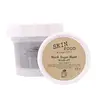What's inside
What's inside
 Key Ingredients
Key Ingredients

 Benefits
Benefits

 Concerns
Concerns

 Ingredients Side-by-side
Ingredients Side-by-side

Water
Skin ConditioningCI 77891
Cosmetic ColorantButylene Glycol
HumectantSilica
AbrasiveGlycerin
HumectantTrehalose
HumectantVolcanic Ash
AbrasivePolyvinyl Alcohol
Bentonite
AbsorbentKaolin
AbrasiveCaprylic/Capric Triglyceride
MaskingGlyceryl Stearate
EmollientStearic Acid
CleansingCetearyl Alcohol
EmollientPvp
Emulsion Stabilising1,2-Hexanediol
Skin ConditioningPEG-100 Stearate
Polysorbate 60
EmulsifyingCI 77499
Cosmetic ColorantHydrogenated Vegetable Oil
EmollientXanthan Gum
EmulsifyingJuglans Regia Shell Powder
AbrasiveSorbitan Stearate
EmulsifyingZea Mays Starch
AbsorbentPolyacrylate-13
Polysorbate 20
EmulsifyingCI 77492
Cosmetic ColorantMannitol
HumectantMicrocrystalline Cellulose
AbsorbentLactic Acid/Glycolic Acid Copolymer
Skin ConditioningLactic Acid
BufferingPolyisobutene
CI 77491
Cosmetic ColorantMenthoxypropanediol
MaskingTetrasodium Pyrophosphate
BufferingDisodium EDTA
Ethylhexylglycerin
Skin ConditioningSorbitan Isostearate
EmulsifyingAluminum Hydroxide
EmollientTriethoxycaprylylsilane
Tocopherol
AntioxidantWater, CI 77891, Butylene Glycol, Silica, Glycerin, Trehalose, Volcanic Ash, Polyvinyl Alcohol, Bentonite, Kaolin, Caprylic/Capric Triglyceride, Glyceryl Stearate, Stearic Acid, Cetearyl Alcohol, Pvp, 1,2-Hexanediol, PEG-100 Stearate, Polysorbate 60, CI 77499, Hydrogenated Vegetable Oil, Xanthan Gum, Juglans Regia Shell Powder, Sorbitan Stearate, Zea Mays Starch, Polyacrylate-13, Polysorbate 20, CI 77492, Mannitol, Microcrystalline Cellulose, Lactic Acid/Glycolic Acid Copolymer, Lactic Acid, Polyisobutene, CI 77491, Menthoxypropanediol, Tetrasodium Pyrophosphate, Disodium EDTA, Ethylhexylglycerin, Sorbitan Isostearate, Aluminum Hydroxide, Triethoxycaprylylsilane, Tocopherol
Sucrose
HumectantPEG-7 Glyceryl Cocoate
EmulsifyingGlycerin
HumectantEuphorbia Cerifera Wax
Macadamia Ternifolia Seed Oil
EmollientCaprylic/Capric Triglyceride
MaskingCetyl Ethylhexanoate
EmollientLanolin
EmollientStearalkonium Hectorite
Gel FormingButyrospermum Parkii Butter
Skin ConditioningLimnanthes Alba Seed Oil
Skin ConditioningCaramel
Cosmetic ColorantSorbitan Laurate
EmulsifyingTocopheryl Acetate
AntioxidantEthylhexylglycerin
Skin ConditioningWater
Skin ConditioningParfum
MaskingSucrose, PEG-7 Glyceryl Cocoate, Glycerin, Euphorbia Cerifera Wax, Macadamia Ternifolia Seed Oil, Caprylic/Capric Triglyceride, Cetyl Ethylhexanoate, Lanolin, Stearalkonium Hectorite, Butyrospermum Parkii Butter, Limnanthes Alba Seed Oil, Caramel, Sorbitan Laurate, Tocopheryl Acetate, Ethylhexylglycerin, Water, Parfum
 Reviews
Reviews

Ingredients Explained
These ingredients are found in both products.
Ingredients higher up in an ingredient list are typically present in a larger amount.
This ingredient is an emollient, solvent, and texture enhancer. It is considered a skin-softener by helping the skin prevent moisture loss.
It helps thicken a product's formula and makes it easier to spread by dissolving clumping compounds.
Caprylic Triglyceride is made by combining glycerin with coconut oil, forming a clear liquid.
While there is an assumption Caprylic Triglyceride can clog pores due to it being derived from coconut oil, there is no research supporting this.
Learn more about Caprylic/Capric TriglycerideEthylhexylglycerin (we can't pronounce this either) is commonly used as a preservative and skin softener. It is derived from glyceryl.
You might see Ethylhexylglycerin often paired with other preservatives such as phenoxyethanol. Ethylhexylglycerin has been found to increase the effectiveness of these other preservatives.
Glycerin is already naturally found in your skin. It helps moisturize and protect your skin.
A study from 2016 found glycerin to be more effective as a humectant than AHAs and hyaluronic acid.
As a humectant, it helps the skin stay hydrated by pulling moisture to your skin. The low molecular weight of glycerin allows it to pull moisture into the deeper layers of your skin.
Hydrated skin improves your skin barrier; Your skin barrier helps protect against irritants and bacteria.
Glycerin has also been found to have antimicrobial and antiviral properties. Due to these properties, glycerin is often used in wound and burn treatments.
In cosmetics, glycerin is usually derived from plants such as soybean or palm. However, it can also be sourced from animals, such as tallow or animal fat.
This ingredient is organic, colorless, odorless, and non-toxic.
Glycerin is the name for this ingredient in American English. British English uses Glycerol/Glycerine.
Learn more about GlycerinWater. It's the most common cosmetic ingredient of all. You'll usually see it at the top of ingredient lists, meaning that it makes up the largest part of the product.
So why is it so popular? Water most often acts as a solvent - this means that it helps dissolve other ingredients into the formulation.
You'll also recognize water as that liquid we all need to stay alive. If you see this, drink a glass of water. Stay hydrated!
Learn more about Water